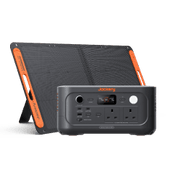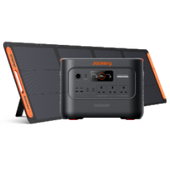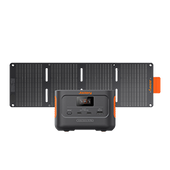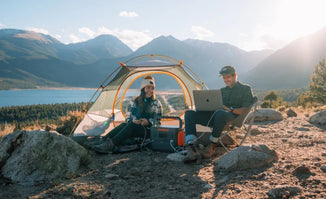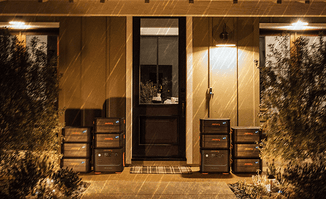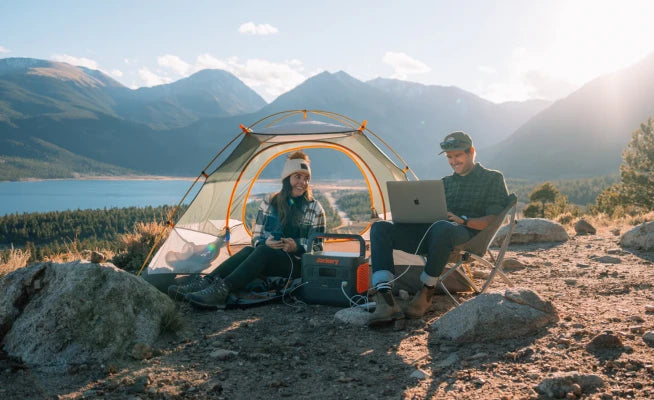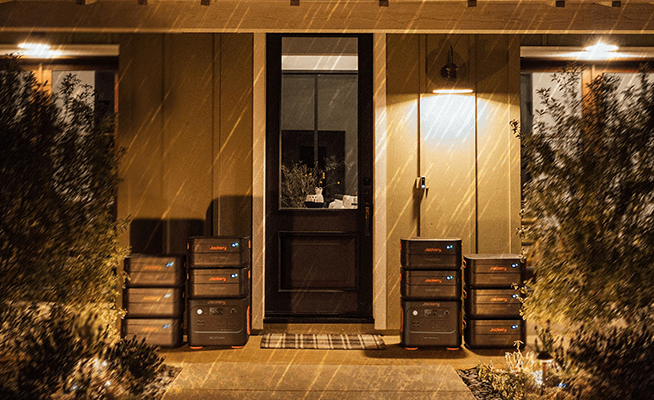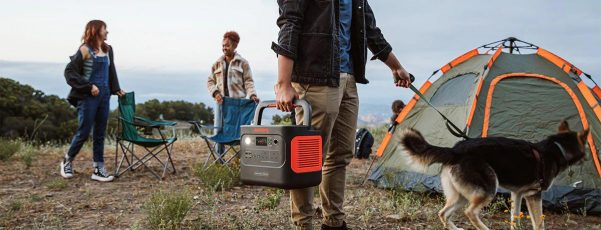Have you ever found yourself on a hike through the UK’s beautiful landscapes, only to discover your phone is dead, your camera won’t turn on, or your campsite light fails to turn on just as dusk begins to fall? It is a situation that catches many hikers off guard, directly affects the quality of their experience, and compromises their safety in the unknown outdoors.
However, traditional small power banks being used by many hikers are not enough to power multiple essential appliances. Similarly, gas generators are too bulky and noisy to carry on walking holidays.
In contrast, silent electric generators with solar power seem to be the ideal solution for hiking essentials. Why is this the case, and what should you bring on a hike? Let's explore these questions further.
Power Demand Scenarios for Walking Holiday
During walking holidays and hiking experiences, you should expect to have the following power demands. Understanding these energy demands is important as it will help you pack your hiking essentials in a better fashion.
1. Cameras and Drones
Cameras and drones have become common tools for recording high-quality images and video footage during trips. These devices are power-hungry and usually need multiple recharges throughout the day. When you are photographing sweeping mountain views or capturing slow-motion clips of coastal paths, the battery of these appliances drains quickly.
If you do not have a reliable way to recharge these appliances, they will only become a dead weight in your backpack. That is why access to portable power ensures you do not miss capturing important memories that will last with you throughout your life.
2. Mobile Phones
A functional mobile phone will help you maintain contact with anyone you need, irrespective of how remote your trip becomes. Apart from that, mobile phones are also needed as a navigation device and a weather monitor. As a matter of fact, mobile phone batteries can be consumed quickly in mountainous regions.
3. Ensure Safety
Safety on the trail depends largely on visibility and your ability to navigate the terrain, especially during changing weather or fading daylight. Compact lighting tools such as headlamps or handheld torches are essential for navigating uneven paths, setting up camp, or moving through low-light areas.
Similarly, GPS devices offer precise location tracking that is impossible to achieve using physical maps. Learning how to use a GPS device for hiking can significantly improve your confidence and route accuracy in unfamiliar terrain. Without a reliable power source, however, these devices can fail when they are needed most.
4. Wearable Devices
Smartwatches and fitness trackers are considered common hiking accessories, especially for those who monitor physical performance during long-distance walks. These devices provide real-time data on heart rate, altitude, distance covered, and overall exertion. However, their compact size comes with limited battery capacity, often requiring daily charging.
5. Small Fans, Hand Warmers, and Other Equipment for Comfort
After a long day on the trail, you will need multiple devices that can help you unwind comfortably. Devices like small fans, hand warmers, and rechargeable lanterns may seem secondary, but they play a practical role in recovery, helping improve sleep quality and overall rest. Without them, even a well-planned trip can feel tiring and unsettled by nightfall.
Why Solar Generators Are Hiking Essentials for Walking Holiday
1. Perfect Match for Environmentally Friendly Travel
Hiking and camping are often chosen for their closeness to nature. People step away from the world to reconnect with quiet landscapes and fresh air. Carrying gear that respects the environment is a natural extension of that mindset.
Solar generators support this approach without forcing you to compromise on the quality of your experience. They operate without fuel, produce no emissions, and function silently, making them suitable for national parks, nature reserves, and remote trails. In fact, many campsites do not allow gas generators, so solar generators become an excellent choice for these places.
2. Power Guarantee Anytime and Anywhere
When you are out in open terrain, you will no longer be dependent on charging stations or campsite hookups. A solar generator gives you the freedom to recharge your devices wherever you want. This self-sufficiency becomes particularly valuable on multi-day hikes or in locations far from the established facilities.
3. Economical and Practical Long-term Investment
While a silent electric generator may require more upfront investment than a standard power bank, it promises long-term financial returns. There are no ongoing fuel costs, no need for replacement batteries, and no dependency on paid charging infrastructure. Once purchased, it becomes a stable, reusable energy source that will continue to serve your walking holidays for years to come.
4. Diverse Functions and Adaptability to Multiple Devices
A modern generator for a house is designed to support a variety of devices at the same time. With multiple output ports, they can charge phones, drones, lights, GPS units, and wearables without extra adapters. This flexibility enables it to be easier to manage your gear and ensures everything stays powered throughout your walking holiday.
Jackery Solar Generator 240 v2 for Waling Holiday
We proudly introduce our Jackery Solar Generator 240 v2 for outdoor enthusiasts who need portable and reliable electricity on the go during a walking holiday.
1. Powerful
This compact unit weighs only 7.94 lbs and offers a robust 256Wh capacity. It boasts 300W of rated output, with a surge capacity of up to 600W, giving you enough energy to charge and operate essential electronics throughout the day and night.
Comes with one AC outlet, one USB-A outlet, and two USB-C outlets, this model permits users to operate a number of devices at once. The updated USB-C port delivers 100W bidirectional fast charging, so people can rapidly and efficiently power up their phone, tablet, or drone while enjoying the walking holiday.
2. Multiple Charging
With multiple charging options, it gives you flexibility to recharge the unit in a wide variety of conditions. For instance, you can quickly top its battery up in one hour through emergency AC charging. Standard wall charging takes around two hours, while car charging completes in five hours. When paired with the 40W SolarSaga panel, it charges fully via solar in approximately 11 hours.
3. Durable and Safe
Its built-in LiFePO₄ battery can support up to 3,000 full cycles, which boasts a potential lifespan of around 10 years before its performance drops below 80% capacity. In addition, the Jackery Solar Generator 240 v2 is IEC-certified, equipped with 52 layers of internal protection, and meets FCC EMI Class B standards to ensure low interference with nearby devices. The upgraded ChargeShield 2.0 system prevents overcharging, short circuits, and overheating during extended use.
4. Smart

On top of this, the Jackery Solar Generator 240 v2 supports Bluetooth and Wi-Fi connectivity, allowing remote monitoring and control through the Jackery app. You can check the remaining battery life and charging status and switch operating modes, all from your phone.
In terms of real-world usage, this generator can recharge a smartphone over 11 times, run a small light for 21 hours, power a drone several times, and even support small appliances like fans or electric blankets for multiple hours. All of this comes in a device that fits easily in a standard backpack, thanks to its foldable handle and compact frame.
The Guide to Walking Holiday
Now let's have a look at how to plan your walking holidays in the UK. In order to do so, you will first need to understand the types of hiking holidays.
1. Walking Holiday Types
Walking holidays in the UK showcase flexibility for different kinds of travelers. Some prefer the structure and local knowledge that comes with a guide-accompanied tour. These trips are planned in detail, often include accommodation and meals, and provide an experienced leader to navigate the route and explain the surrounding area. They are especially helpful for newcomers or those exploring more challenging terrains.
Others may choose to travel independently. Free travel gives you full control over your pace, route, and daily schedule. You can stop when you want, take detours, and adapt your trip based on the weather or your energy level. This approach suits those who value solitude or have prior hiking experience.
Both options have their own strengths, and the type of holiday you take simply depends on what kind of experience you are looking for.
2. Route Recommendation
Here are some top destinations in the UK to explore on walking holidays.
(1) Lake District National Park
This region defines the classic British walking experience. Routes such as Helvellyn and Catbells offer manageable climbs with panoramic views over reflective lakes and rolling green hills. The area is deeply linked to the poetry of William Wordsworth, whose writing was shaped by these surroundings.
The Cotswolds are best known for their charm and slower pace. Villages built from warm honey-colored stone sit among lavender fields and quiet woodlands. Bibury is a popular starting point. Here, a relaxed stroll through the countryside often ends with tea in a local café. It is an ideal choice for those who want gentle paths paired with cultural stops.
Stretching over 600 miles, this is England’s longest national trail. It covers dramatic coastlines, beaches, cliffs, and fishing villages. The section around Land’s End is particularly popular, with the chance to spot a colony of seals. This route is best tackled in segments and offers some of the most scenic seaside views in the country.
Hikers here take on the challenge of Yr Wyddfa (Mount Snowdon), Wales’ highest peak at 1,085 meters. The climb is rewarding and accessible by several routes. After reaching the summit, many choose to descend by steam train, which brings a scenic and relaxing end to a demanding walk.
This landscape presents a more rugged and isolated experience. The West Highland Way stands out as a multi-day route known for its wide-open glens and cinematic backdrops. Along the way, stories of the Loch Ness Monster add to the folklore, while parts of the route may feel familiar, as some scenes from the blockbuster Braveheart were filmed here.
The Yorkshire Dales reflect the character of England’s rural heritage. The limestone gorge at Malham is a standout feature, while the surrounding countryside is dotted with dry-stone walls, grazing sheep, and small farming villages. After a full day of walking, it is common to enjoy a proper Yorkshire pudding in a local inn.

Wrapping-Up
Walking holidays across the UK give you an opportunity to enjoy natural beauty while also testing your limits at the same time. To make the most of this experience, reliable power is essential. A portable power bank like our Jackery Solar Generator 240 v2 supplies a dependable solution that supports your equipment without adding unnecessary weight or noise.












